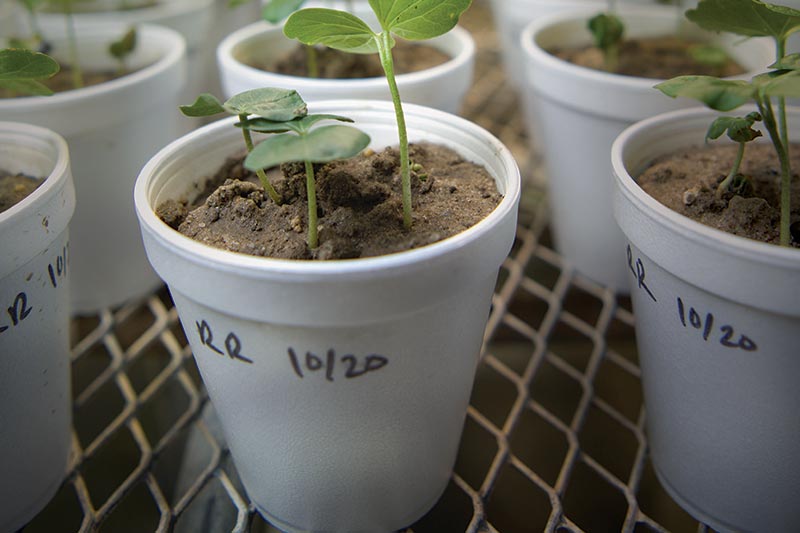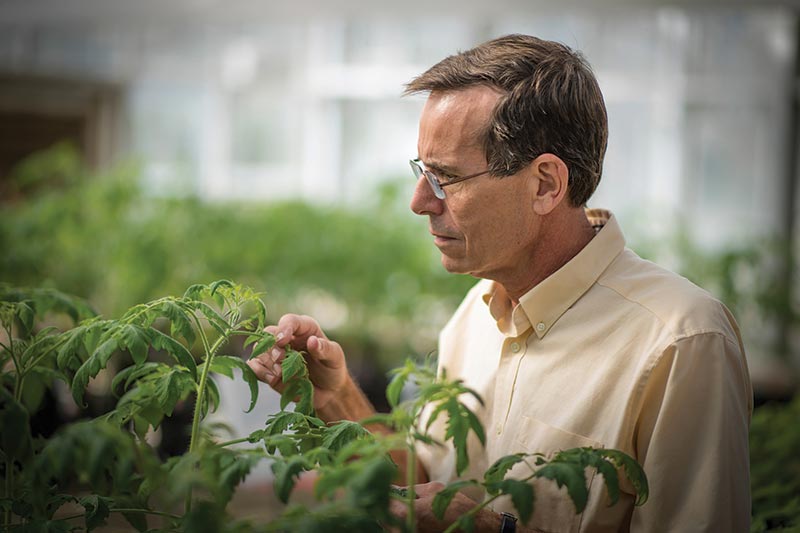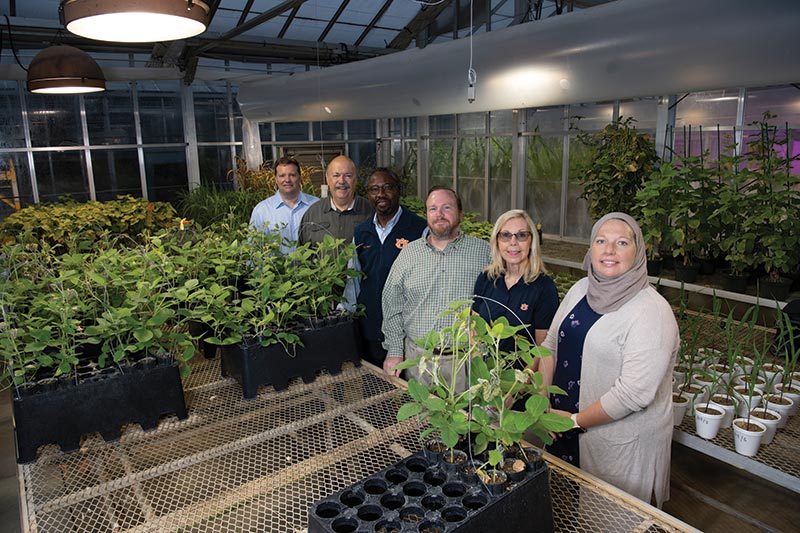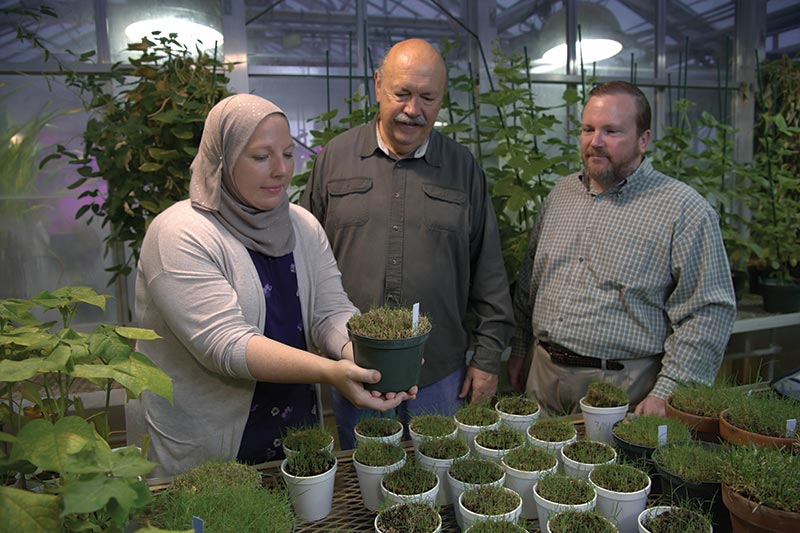PGPR discovery becomes accepted practice in agriculture
Article body
Like a lot of great discoveries, PGPR, or plant growth-promoting rhizobacteria, came about when someone wasn’t particularly looking for it.
“I coined the term PGPR in a publication from my Ph.D. research in 1978,” said Dr. Joe Kloepper, Alumni Professor in the College of Agriculture’s Department of Entomology and Plant Pathology. “My research assistantship in Berkeley was to work on biological control of potato diseases. While I was testing rhizosphere bacteria for this, I found that some strains had no biological control capacity, but they did promote growth of the potato plants.”
This “unintentional” discovery has evolved into a technology that is becoming a standard input in crop production and has spawned numerous other groundbreaking research projects across several disciplines.
Kloepper’s research primarily focuses on using beneficial bacteria for promoting plant growth, plant health and nutrient uptake.
The emphasis is on various species and strains of the spore-forming bacilli because spores of these PGPR remain viable as seed treatments for a long period of time, thereby increasing the opportunities for integrating PGPR into current agricultural practices.
“Many of the agricultural chemical companies have added biological components to their products, and this has enabled Auburn University to have license agreements with major companies such as Bayer,” Kloepper said.
There is a growing acceptance, he said, for using these kind of bacteria as a standard practice in agriculture.
“This is especially true for seed treatments in production agriculture, which is the biggest use of this technology now,” Kloepper said. “These seed treatments are being used for all traditional row crops, including corn, soybeans and others."
The first applications of these bacteria were made on vegetable crops, with the PGPR put into the irrigation water on specialty crops in Florida and California.
“But now, with the seed treatments, it has expanded so there’s a lot more acreage being treated,” he said. “Farmers buy seeds, and seeds have various components placed on them, including chemicals, fungicides and insecticides. We’re seeing that more of the companies want to sell farmers seed that have biologicals on them, and that’s where the PGPR comes in.”
The benefits of PGPR fall into two categories, Kloepper said.
“One is that there’s increased growth promotion. If farmers use these in cold soils, there will be quicker establishment of the plant, better root systems and better overall growth.”
Another area of interest for the use of PGPR is in helping with nutrient uptake, or fertilizer use efficiency, Kloepper said.
“Farmers have to spend a lot of money for fertilizer, but a certain percentage of the fertilizer that is applied is not taken up by the plant,” he said. “Several researchers have found that PGPR can increase the amount of fertilizer taken up by the plant. This also has the spinoff of less environmental pollution.”
One PGPR strain has been licensed for use as a biofertilizer and biopesticide in numerous seed and soil applications, and another license is under negotiation with a different company for additional applications.
Kloepper and his colleagues have also developed additional bacterial libraries of strains from long-term crop rotations and other sources. Auburn currently has one of the richest collections of PGPR strains in the world.
PGPR have also shown promise by increasing tolerance to drought, attracting beneficial insects, repelling destructive insects and combating other pests or disease-causing agents, such as nematodes, bacteria and fungi.
Modes of action are being studied and effects on plant growth, plant pathogens and plant-damaging insects are being evaluated in collaborations with other faculty in the College of Agriculture, College of Sciences and Mathematics, School of Forestry and Wildlife Sciences and the USDA Soil Dynamics Lab in Auburn.
Dr. Henry Fadamiro’s laboratory in the Department of Entomology and Plant Pathology is focusing on investigating the effects of PGPR in mediating plant-insect interactions.
“Specifically, we are interested in how treating plants with PGPR affects the biology and behavior of insect pests of important row and vegetable crops and their natural enemies,” said Fadamiro, associate dean for research for the College of Agriculture and associate director of the Alabama Agricultural Experiment Station.
A related project in the laboratory of entomology professor Dr. David Held is focused on the use of PGPR treatments to manage pests of turfgrass and ornamental plants.
Researchers are also studying the chemical, biochemical and molecular mechanisms by which PGPR affect plant-insect interactions.
“Our research has helped to establish that the treatment of plants with specific PGPR strains can result in chemical and molecular changes that will make the plants less attractive to insect pests but highly attractive to [the pests'] natural enemies,” Fadamiro said.
This research has attracted significant industry funding, supported the training of many graduate students and postdoctoral researchers, and resulted in several high-impact publications and patents, he said.
“In addition, our research team has identified specific PGPR strains with insecticidal activity, which can be used to control certain insect pests and reduce plant damage,” Fadamiro said. “Knowledge of the effects of PGPR on plant-insect interactions has contributed to the increased adoption of PGPR products and development of better products, while mitigating against potential negative impacts of these products.”
Dr. Kathy Lawrence, a professor in the Department of Entomology and Plant Pathology, has worked with Kloepper and his PGPR collection for 20 years.
“We have screened 700 of his isolates to look for plant growth promotion and nematicidal activity with the three most damaging nematodes in Alabama crops,” Lawrence said.
Many of these isolates from Kloepper’s collection were identified to have activity toward the root knot nematode and enhanced cotton yields.
Professor Dr. Mark Liles’s laboratory in the Department of Biological Sciences has been working for many years on the use of PGPR for preventing disease in fish.
“In an initial study, we evaluated a large collection of bacterial isolates from plant rhizospheres—from Kloepper’s collection—to identify those that inhibited the growth of major fish pathogens,” Liles said. “We found that our best-performing probiotic strain is effective at reducing mortality due to multiple fish pathogens.”
After these studies, a pond study in which fish were fed with control feed versus spores of Kloepper’s PGPR strain showed that coating feed with the probiotic significantly enhanced catfish growth and reduced nitrogen and phosphorus in pond water.
“Now that we have seen such promising results for specific probiotic strains in fish, we are working on understanding the mechanisms by which these probiotics protect fish from pathogens and improve fish growth performance, as well as ways to enhance their efficacy,” Liles said.
“For example, we know this PGPR strain makes the antibiotic difficidin, and that this antibiotic is responsible for the direct inhibition of multiple aquaculture pathogens. But we also have evidence that the probiotic has other beneficial effects on fish besides production of the antibiotic, so we want to understand these other mechanisms so we can better use this probiotic for aquaculture applications,” Liles said.
Interestingly, this same Kloepper strain has also been effective in biocontrol of the bacteria that causes citrus canker in tomato.
“It was in this study that we discovered that PGPR strains can use plant-derived pectin as a growth substrate,” Liles said. “Importantly, this implied that we could improve how well the probiotic survives and grows when applied to the seed of a plant or introduced into the gut of a fish.
“Also, in collaboration with Kloepper, we recently published that the combination of Bacillus velezensis spores together with a pectin-rich agricultural waste (orange peels) can enhance the probiotic effects in soybean and resulted in dramatically enhanced soybean nodulation. We are now evaluating whether this symbiotic approach—prebiotic and probiotic—can enhance catfish growth, while using strains singly or in combination.”
Working with Liles are professors Dr. Allen Davis, Dr. Eric Peatman and Dr. Jeff Terhune from the School of Fisheries, Aquaculture and Aquatic Sciences, and Dr. Ben Beck of the USDA Agricultural Research Service.
Researchers and extension specialists in Auburn’s College of Agriculture are joining forces on a project that could provide a fertilizer alternative to Alabama livestock producers currently using synthetic nitrogen on bermudgrass.
Preliminary data indicate that PGPR may hold promise as an alternative to synthetic nitrogen fertilizer for biofertilization and forage quality enhancement of bermudagrass for livestock.
“We are altering the diet of the soil,” said Dr. Leanne Dillard, a member of the project team and an assistant professor and extension specialist in the Department of Animal Science. “We’re not adding something new. These PGPR are already in the soil. All we’ve done is concentrate them so that their small effect becomes a large effect.”
Other members of the team include Held and Dr. Russ Muntifering, a professor and graduate program officer in the Department of Animal Sciences.
Auburn University is a nationally ranked land grant institution recognized for its commitment to world-class scholarship, interdisciplinary research with an elite, top-tier Carnegie R1 classification and an undergraduate education experience second to none. Auburn is home to more than 30,000 students, and its faculty and research partners collaborate to develop and deliver meaningful scholarship, science and technology-based advancements that meet pressing regional, national and global needs. Auburn's commitment to active student engagement, professional success and public/private partnership drives a growing reputation for outreach and extension that delivers broad economic, health and societal impact. Auburn's mission to educate, discover and collaborate drives its expanding impact on the world.





